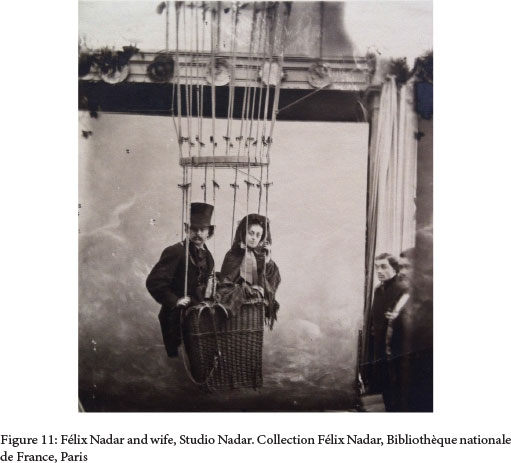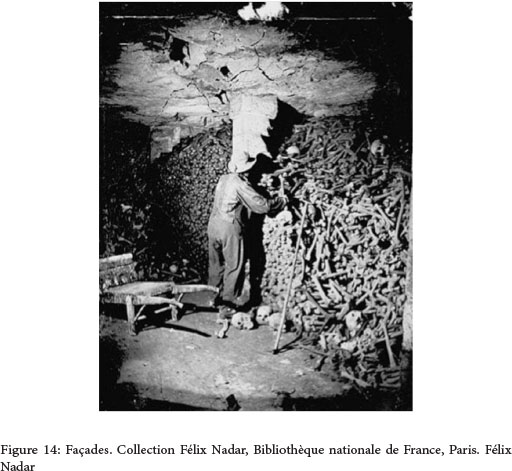Servicios Personalizados
Articulo
Indicadores
Links relacionados
-
 Citado por Google
Citado por Google -
 Similares en Google
Similares en Google
Compartir
Kronos
versión On-line ISSN 2309-9585
versión impresa ISSN 0259-0190
Kronos vol.42 no.1 Cape Town nov. 2016
http://dx.doi.org/10.17159/2309-9585/2016/v42a6
ARTICLES
The production of Red: aesthetics, work and time
Patricia Hayes
Centre for Humanities Research, University of the Western Cape
ABSTRACT
This article considers the installation Red from several vantage points. There is an almost photographic quality to certain long industrial landscape shots from East London in the documentary film. As they are spliced together with interviews about labour struggles at the Mercedes plant at the beginning of South Africa's democratic transition, the temporal and visual displacements evoke Adorno's notion of the exchange structures of history. Too much happened in that time to be processed and it must be refabricated and revisited: Red is one mode of doing so. Kracauer's approach to film is invoked with its emphasis on the simultaneous happening of recording and revealing. The material elements in the installation that reference the beds and uniforms of workers (and their ingenuity) are read alongside the aeronautical and subterranean experiments of Nadar in nineteenth-century Paris, who posed mannequins as humans underground in order to overcome the technological limits of photography at the time and to fabricate the real. The article ends with an exploration of other film works by Gush that deal with work, leisure and inventiveness, some of which arise almost incidentally from his journeys to document Red.
The Exchange Structures of History
Art work is sometimes driven by what Adorno calls the 'exchange structures of history'. In a recent essay about South African documentary photography in the 1980s, I suggest that photographers do not only work in a simple cause-and-effect way to 'capture' what is going on around them, even though some of them say this is what they do.1 Instead, it is apparent that a deep sediment of practice builds up which produces a well-established and rich photographic culture that incrementally feeds into a climate of visual surfeit in which many are producing and consuming. The way the exchange structures of history become manifest is through a prior and strongly felt visual deficit or desire - as in 1976 when some of the Soweto protests could be addressed but other events such as the murder of Biko could not - that produces an urgent sense of lack. This might encompass lack of visibility, clarity, photography and by extension photographers to do that work, especially in terms of 'exposing' injustice. This in turn generates a response that accumulates exponentially over the years, leading to that visual climate of surfeit and even repetition, but which carries in it the weight of displacements and deferrals from previous failures to represent.

I am going in this direction as a response to the film Red by Simon Gush and James Cairns. This incorporates long views of East London's industrial landscape and architecture filmed in high resolution monochrome, which in many ways resemble photographs. The film includes interviews with the main protagonists of the labour dispute in 1990 and the red car assembly process at Mercedes-Benz. Its play with shades of black and white might hit certain notes from the documentary photography of the period of political struggle in which the events of the film are preceded. But the events themselves cannot be represented because they have lapsed, and must be reconstructed in various ways through the spoken narratives of the film's interlocutors that are then cut and spliced in the sequencing of the film whose sound is often played against a background of landscapes, filmed very recently. Interviews with Simon Gush foreground his father's recounting of the historic episode while driving the artist to the airport after a family visit to Port Elizabeth a few years ago, which seems to have triggered the entire project. The complex temporal architecture and spatial reconstitutions of any documentary film in fact constantly play with exchange structures of history and displacement, but they are of particular interest here in Red.
To return to the aesthetic echoes from the documentary decade of the 1980s, the film does not produce 'events' in the ways many photographers sought to do in the mid- to late 1980s. Red works between oral histories and long (nearly still) landscape shots. Chávez Mac Gregor draws attention to the poetics of such an approach, over any mode of denunciation.2 Landscape work was in the background of the photographic oeuvre that tended to feature in the 1980s. Mdu Xakaza argues that what we call landscape usually only provided the backdrop for other dramas, giving rise to the term 'visual furniture' by David Goldblatt.3 Landscape was not of special interest until taken up by photographers such as Goldblatt and Santu Mofokeng, who were at the same time wary of genre categorisations and distinctions. There is in fact a great deal of historical photographic work that can be described as 'landscape'. This includes specifically urban landscape work, such as that commissioned in the 1950s from photographers such as Constance Stuart Larabee and Leon Levson, marking the modernist city of Johannesburg.4 More generally and historically in southern Africa the notion of landscape tends to mark the opposite of modernism. This instates certain terrains outside of progress and sometimes, under local versions of indirect rule, these belong to 'the Native'.5 Most intriguing of all perhaps are the excursions made by Alfred Duggan Cronin out of Kimberley (where he did portraits of migrant workers) back to the 'sending areas' of his subjects, including the Eastern Cape and the Matopos hills in Zimbabwe in the 1920s and 1930s. Here he photographed the exact sites of military and colonial conquest that turned former warriors into migrants, but which often had much older 'precolonial' resonances as well.6
There is often a displacement that goes with landscape that carries its own potential for amplitude. One of the things that landscape therefore permits is head space: room for meditation, association and thought, rather than the more emotional and political confrontation of the close-cropped humanist lens directed at specific audiences. In the film Red a distinctive tension is set up between the voices articulating a situation and struggle from 25 years ago, and the large formal shots of the hard lines and spaces of industrial modernism in the same frame as vast skies or seas in tones of grey, with their everyday movements and traffic. The viewer is not visually confronted in the same way as in the 1980s, but is offered a set of associations to look into, and (if they wish) away from, while aurally processing the oral equivalent of the 1980s photograph.
So far we have been referring to the film. But what kind of assembly is the larger installation Red? Putting art and production together, it references multiple aspects of the factory sleep-in at East London, in belated, fabricated, and related ways. Besides the film, components include red car body parts, as well as uniforms and bedding made from car upholstery material. It might be appropriate to think of Red altogether as an 'aesthetic matrix of a particular historical experience'.7 The fabrication of the red car itself in 1990 becomes the aesthetic matrix of a particular labour and political experience in the space of the factory, with a projection into the future through its tribute to the black president-in-waiting Nelson Mandela, who was recently out of prison.
In Miriam Bratu Hansen's revisiting of Siegfried Kracauer's Theory of Film, she highlights the way film and cinema for Kracauer offered a 'specifically modern episteme, at once an expression of and a medium for the experience of a "disintegrating" world'. While cinema arose from and engaged with processes associated with modernisation - 'mechanisation, standardisation, disembedding of social relations' - it also provided an accessible means to recognise and negotiate their effects.8 Can we access the kinds of questions Kracauer asked of cinema concerning the experience of a historical moment in the factory? In a sense this is what Gush tries to do with different media in Red.
There are distinctive features and implications in Kracauer's analysis of cinema, according to Hansen, that might be suggestive for Red. The cognitive potential of cinema was tied up with its 'pivotal role in the restructuring of sense perception, of the very conditions of experience and subjectivity'. This in turn has a bearing on the 'materialist enquiry' in which Kracauer engaged, into the meanings and directions produced by modernisation and industrialisation. Kracauer's concern was not with authenticity or verisimilitude but rather with film's ability to encounter and articulate materiality, to bring about a 'process of materialisation'. This might carry symptoms of disintegration or alienation, but it might also bring more 'liberatory impulses'. This is because film is able to 'confront "intention with being", with existence, facticity, and contingency'. This undermines not only the 'sovereign subject of bourgeois ideology', it also unsettles
a larger anthropocentric worldview that presumes to impose meaning and control upon a world that increasingly defies traditional distinctions between the human and the nonhuman, the living and the mechanical, the unique (integrated, inner-directed) individual and the mass subject, civilisation and barbarism … hence his [Kracauer's] interest in early cinema, its scientific and inventorizing drives, its 'jumble' of subjects and styles.
As Kracauer insists, 'The material elements that present themselves in film directly stimulate the material layers of the human being: his nerves, his senses, his entire physiological substance'.9 Thus material phenomena have a potentially unsettling effect on the boundaries of individual subjectivity and identity. But where Kracauer sees this in film, the material dimension is far more striking in another assembly of things in Red, and that is in the empty strike uniforms and beds fashioned from the upholstery material. Where the film is comparatively seamless, smoothly overlapping with or switching between spoken narratives and enigmatic urban and industrial views, the uniforms (with visible seams) materialise the interchanges between the human and the machine, and the relationship between upholstery and the needs of the worker's body. This is where at first glance we seem to get a material impact from Red, more obviously than from the filmic, though they are closely connected within the aesthetic matrix of the entire production.
Granted that the human-nonhuman relationship is much more striking in the three-dimensional uniforms, producing distinct phenomenological effects. But this is no reason to leave the image behind. Instead of moving away from it, I would like to examine the actual photographic basis of film more deeply. This chimes in with Kracauer's insistence on 'the photographic approach', often misunderstood by critics as a naive realism. Kracauer's investment has little to do with traditional art historical understandings of iconicity or indexicality. Rather, as Hansen argues,
the same indexicality that allows photographic film to record and figure the world also inscribes the image with moments of temporality and contingency that disfigure the representation. It is in this sense that the slippery term 'affinity' (of the medium with material reality) includes both film's ability to record and its potential to reveal something in relation to that world.10
This is rather harder to sense in the assembly of Red, requiring us to focus on the long shot as it were. In tune with other projects under the rubric of Work such as the suspenseful Sunday Light and After the Work Stopped,11 Gush situates the 'action' in Red outside the assembly plant before the work starts, resulting mostly in stillness. This is then probed - even disturbed - by the contingent movements caught on the rolling camera, in the manner of observational cinema. As Kracauer proposes, a film aesthetics grounded in the medium of photography gives latitude to its 'perplexing ability' to both resemble the world and simultaneously 'render it strange'.12
In order to explore this further, and before circling back to Red, I wish to enter another set of matrices featuring the medium of photography. This is through the work of Gaspard-Félix Tournachon, better known as Nadar (1820-1910). Nadar offers another way to think about politics, technology, progress and labour, from an earlier period in the nineteenth century when the processes of their assembly were somewhat more obvious.
'Explorer in the Medium': Nadar and the Photographopolis
Nadar is best known for his famous photographic studio in Paris, which generated portraits of the leading literary and political figures of the Second Empire. Many of these were not-‐so-‐secret Republicans.
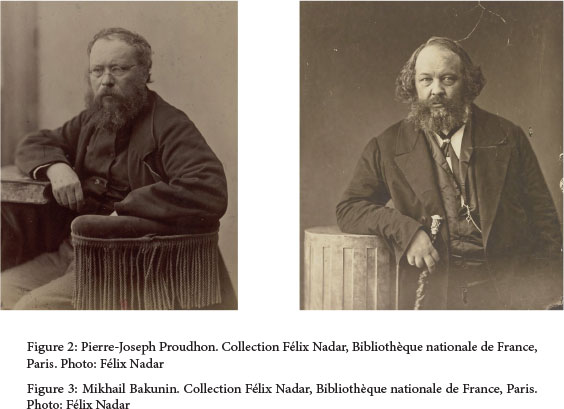
He wrote a number of hyperbolic texts about photography, incorporating his many interests and adventures that included pioneering work with electric flash experiments in 1861 in the Paris catacombs, and the first attempts at aerial photography including the launch of a great balloon called Le Géant that ended in disaster near Hanover. Nadar endows photography with very powerful agency. In his short story 'Homicidal Photography', for example, mob justice is dispensed on the basis of a sensational news photograph of a murder in the popular press. He and his friends were endlessly resourceful in trying to create bridges between nineteenth-century technologies and other phenomena, one of them going so far as to invent the prototype of the helicopter, while others dabbled in photophony.13 Nadar proudly produced and published portraits of this and other technical experiments taken in his studio.


The cumbersome limits of photography in the nineteenth century presented seemingly insuperable challenges, including the unwieldy apparatus, the delicate chemistries involved, and the problems posed by the length of time needed for successful exposures. When these blocked Nadar's accelerating scientific and inventive desires, which he constantly sought to represent in moments of excess that fused technological innovation and simultaneous expression - 'recording and revealing' - he tried to overcome them in a variety of ways. Two examples will suffice here.
Nadar's experiments with aerial photography were designed to show Paris from the air. This was at a time when Hausmann's plans brought radical new features to the city and destroyed parts of the old, especially where revolutionary barricades were notoriously quick to be assembled. Nadar was among the first of the aeronautical enthusiasts to mount in a balloon and transcend the normative horizons of the city, a feat linked in Stephan Oettermann's view to the 'pricking open' of older autocratic states.14

The launch of the balloon Le Géant in 1863 was a supreme moment in Nadar's life. Production lines of seamstresses were set up in an atelier to sew the silk pieces together by hand that would make the balloon, and the public space was dominated by the build-‐up of preparations and finally lift-‐off.
For Nadar, the experience of being in the air was intoxicating:
[In] the limitless immensity of these hospitable and benevolent spaces where no human force, no power of evil can reach you, you feel yourself living for the first time … and the proud feeling of your liberty invades you.15
But how to portray the actual journey through the clouds in the balloon, when its movement made camera work unfeasible and the weather on this occasion did not allow them to remain aerostatic? How do you photographically record when no pictures could crystallise on the glass plate fast enough? There were two ways, it would seem. First, the drama of the high altitude flight through stormy clouds where the balloon party was blown east in the dark constituted a scene that could only be tackled by the imagination and the skilled hand of an artist. Second, the crash of Le Géant near a railway line near Hanover proved nearly fatal, and Nadar's long--suffering wife was injured. However, they dusted themselves off and made a series of commercial photos in the studio in a fabricated version of the epic voyage, where the production practices are at times leaked at the edges of the frame.
If the entire episode could not be photographically or filmically documented due to technical limitations, then Nadar found ways to supplement or substitute this lack, instating a new product that comes to stand in for history through the compensatory suturing-‐in of another kind of image. Perhaps it is akin to the desiring subjects mentioned by Batchen, who project an idea of photography before it is 'invented'.16 We might conceive this suturing-‐in as an exchange structure of visual history, to address a historical desire. Such portraits of Le Géant make apparent again the effort to picture technological innovation as it happens, even if statically in the studio.
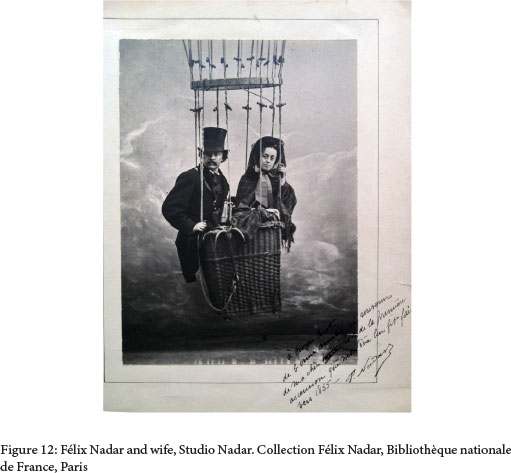
A second episode from Nadar's career is also revealing in terms of his inventive artisanal approach to the leaden technological limits of his time. If he transcended the horizons of mid-‐nineteenth century France in his balloon above the ground, in 1861 Nadar had also descended far below the line of the earth in his ventures into the sewers and ancient catacombs of the city to photograph the streets of the dead. Here in the necropolis he faced the challenge of portraying the catacombs in the profound darkness of their underground location. The Municipal Ossuary was constituted in 1784 by the Conseil d'État and opened the following year in order to relieve the overburdened Cemetery of the Innocents. As things transpired, it was just in time for the French Revolution. As Nadar points out, the 'confused equality that is death' achieved far more than the Revolution. Not only Merovingian kings and the ruling houses of France, but victims of religious and political massacres all 'haphazardly accomplish their decomposition'.17 Marat, Robespierre, Saint-‐Just, Danton and Mirabeau also 'succumbed to the anonymity of the catacombs'.18 By the late nineteenth century it was thought that about eleven million Parisians were entombed below ground. Eduardo Cadava comments: 'Like photography, Paris - as a city that exists both above and below ground - names the intersection of life and death.'19
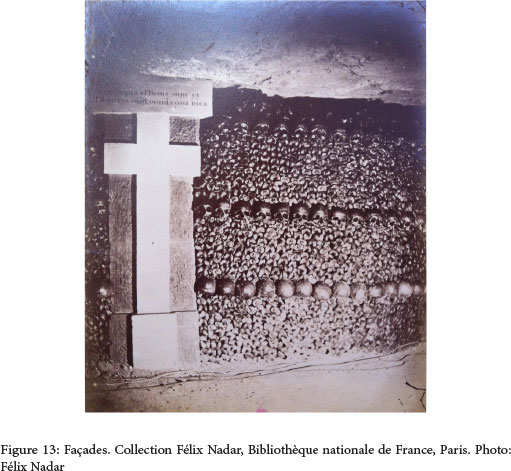
It is here in Nadar's necropolis that a strange resemblance to the Red installation by Gush materialises, where the inanimate is installed to animate. Nadar's photographs include figures in workers' outfits who push wagons, wield shovels and move bones. As Nadar writes:
With each new camera setup, we had to test our exposure time empirically; certain of the plates were found to require up to eighteen minutes. - Remember, we were still, at that time, using collodion emulsion on glass negatives … I had judged it advisable to animate some of these scenes by the use of a human figure - less from considerations of picturesqueness than in order to give a sense of scale, a precaution too often neglected by explorers in this medium and with sometimes disconcerting consequences. For these eighteen minutes of exposure time, I found it difficult to obtain from a human being the absolute, inorganic immobility I required. I tried to get round this difficulty by means of mannequins, which I dressed up in workmen's clothes and positioned in the scene with as little awkwardness as possible.20
As before, there is a suturing that takes place to bring elements together into a larger narrative or portrayal. The mannequins address a certain lack or deficit, they mechanistically 'animate' the dead, they give scale and normality when the abnormal demands of the glass plate on time renders human movement (even breathing) unworkable for the image, requiring a complete ossification of mobility down to the eighteen minutes required for the crystals to finally take shape. This production is then subject to reproduction.
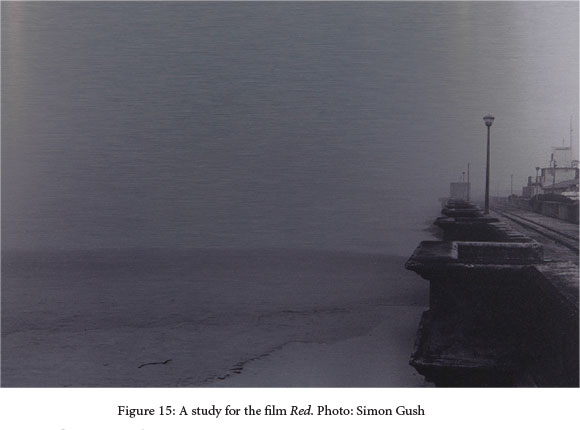
Simon Gush: Work as Repetition, Work as Invention
The empty strike uniforms in Red evoke a material dimension, but I wish to conclude by trying - again - to draw some parallels between medium and materialisations. Commenting on Nadar's Façades series from the catacombs, Cadava dwells suggestively on the theatrical aspect of the mannequin workers, which draws attention to several things. One is the 'death-‐ in-‐life on which Nadar so often insists, the shadowy transitoriness and finitude of all living beings'. With regard to this finitude, Cadava stresses that it is 'a finitude whose traces are unable to be erased, either in life or in death'.21 Alongside these mannequin figures, the photographic image itself has been frequently associated with this flickering between life and death, whether death-in-life or its inverse, life-in-death. But most significantly perhaps for our purpose in thinking of the aesthetic matrix arising from spheres of industrial production, Cadava points to the way that, in Nadar's photographs, Paris is in fact doubled underground. 'Nadar's Paris … is always more than one, which is why, like the mannequins that serve as doubles for the workers, it is another name for repetition and citation, and perhaps for photography itself'.22
The notion of repetition invoked above also pops up in Simon Gush's larger body of work, though with a different inflection. In his 2013 video Calvin and Holiday, he argues that 'most work is, ultimately, menial, repetitive and dull'.23 With such comments he undermines the uplifting ideal of the Calvinist work ethic, which he suggests permeates the South African economy and society, where work is supposed to carry moral value and redeem the individual through a life of labour.
In an uncanny way, the notion of alienating and mind-numbing work is taken to an extreme both in Nadar's inhuman mannequins seeming to toil undergound at the skeletal façades, as well as in Gush's own disembodied work suits from upholstery material, emptied of human forms. Gush's work suits stand as if ossified, freezing the figure of the absent worker, while Nadar's lifelike figures are mortified in their turn by being photographed in the mortuary complex of the catacombs. The process of freezing the worker is taken further by Gush in his meditation on the monuments to mineworkers in Iseeyou, filmed in Johannesburg (2013), which are primarily large statues within the city. Gush's ostensible purpose is to draw attention to how these monuments obfuscate the onerousness of work: 'Despite its centrality, it [work] is not necessarily rewarding or stimulating. Images of work are created through its public representation to ennoble the act of labour'.24 But it is fascinating how the statues join a chain of stand-ins, replicas, doubles and fakes of the worker, which are the work of both the artisan and the artist, and a form of labour itself. And along with absent workers that Gush identifies in many of his video pieces, it is ironic that in Red the workers are present in the factory, but occupying and sleeping instead of working.
Gush's use of the term repetitious to point to the mind-numbing nature of work thus carries a very different connotation to the term repetition used by Cadava, where it implies repeated mechanical and representational activity that produces effects that are unforeseen. This is in the very nature of the rapidly changing mode of life so often rendered as 'modernity'. Production itself might be predictable but representations based on a reproductive process may take an unexpected turn, whose outcome is a doubling that is possibly troubling. But if mechanical reproduction hides the processes of the construction of things, making them appear as if by magic (like the Mercedes car before the workers occupied and demystified the factory), then there are modes of observation of their materialisations that Gush seems to share with earlier thinkers such as Georg Simmel and his one-time student Kracauer, both of whom had the capacity to notice surface phenomena in ways that invited further thought. Hansen reminds us that Kracauer was 'the ragpicker, the intellectual seeking to gather the refuse and debris, the ephemeral, neglected, and marginal, the no longer functional'. He was the one who described the 'ever-faster growing garbage pile of modern history' in his writings on photography and film.25
True to form, in Iseeyou Gush recounts that on his way to film the mineworkers' monument in Johannesburg he noticed an 'ever-faster growing pile' of history. A mound of soil on the side of the road and regular additions from below the ground that flew up without any visible authorship, as it were, caused him to stop and turn his car around. The materialisation of shovelfuls of earth flying through the air to join their kindred sod in the growing pile has a kind of slapstick effect in the deadpan filming that Gush then performed. The method of slow observational film that mundanely tracks the digging below ground in this case heightens an awareness of the absent worker, whose 'own labour was obscured by its representation'.26 Gush seems attracted not so much by the readability of the world as its contingency, and even moments of unreadability. He uses these to point to a central problem of work and the moral ideology that surrounds it, as well as the structures where it is supposed to happen but which often appear as an enigma, and the impingements of work on time that is supposed to be 'leisure'. When he also hints that leisure might in turn impinge on work, it underlines the unpredictable temporal and spatial boundaries between the two, as in the factory scenes at Mercedes-Benz in 1990 that are described in Red.
A masterful conclusion to some of these questions comes in his film Lazy Nigel (2014), which charts Gush's journeys to the East Rand town to interview one of the main protagonists for the film Red. As Gush enters the town on weekends, it is when workers disappear, even before noon. The timing of his arrival is dictated by Gush's own busy work schedule in Johannesburg, and he encounters again a certain ghostliness to the town and its industrial infrastructure. The reasons in Nigel are different from a similar phenomenon he noticed in Geneva in Calvin and Holiday, where construction is going on everywhere but hardly a worker is to be seen. There, like John Berger and Jean Mohr, who dwell on migrant workers in Geneva in their photo-book A Seventh Man, one deduces that mechanisation explains much of this. In Geneva, though, the heavy labour performed by migrants is also curtained from view or carried out through channels that are not easily visible, like the great tunnel works under the discreet city.27 But in the town of Nigel it is the timing of Gush's presence as the working week tapers off that seems to determine the absence of the worker, though a question remains as to whether the workers have simply gone home or the workplace still actually functions, so moribund does it all appear. However, with each successive visit he notices more and more activity on weekends. These are centred on the circus and at fishing sites. In the filming, Gush muses over the mechanical work of machines at the funfair. But then he finally hones in on a man called Ruaan, a pest control operative, at the local dam. Ruaan welcomes being filmed as he tests his remarkable contraption, a cannon he has devised for firing fishing bait into the water. The chorus of celebration over this invention is reminiscent of Nadar and his fearless friends with their prototypes in the nineteenth century. The final comment Gush makes about Ruaan's invention and its successful trial is apt: 'Not work. Not laziness. Something else.'
Conclusion
The tone adopted by Gush in these various works - light of touch, at times bordering on the picaresque - escapes any heavy morality, even as it deals with moral issues of work, inequality, race and history. As he documents himself on his travels to document the reconstructions of what happened in East London in the Mercedes-Benz plant in 1990, the harvest of additional films to Red make for a wider aesthetic matrix. These recordings that reveal things point not only to the injustices of history, but to the exchange structures of history mentioned at the outset of this essay. With their wry humour, however, and notes on their own making, they break up some of the hard sediment of South Africa's old visual surfeit. The Production of Red: Aesthetics, Work and Time
1 See Patricia Hayes, 'Unity and struggle' in Okwui Enwezor and Rory Bester (eds), Rise and Fall of Apartheid (New York: International Center for Photography, 2012), 346. [ Links ] The reference to Theodor Adorno is from his History and Freedom: Lectures 1964-1965 (London: Polity, 2006), 94.
2 Helena Chávez Mac Gregor, 'Introduction' in Simon Gush, Work (Cape Town: Stevenson, 2014), 2. [ Links ]
3 Mzuzile Mduduzi Xakaza, 'Power Relations in Landscape Photographs by David Goldblatt and Santu Mofokeng' (Unpublished PhD thesis, University of the Western Cape, 2016). [ Links ]
4 See Darren Newbury, Defiant Images: Photography and Apartheid South Africa (Pretoria: UNISA Press, 2009), ch 1. [ Links ] Simon Gush's portrayal of Johannesburg in Sunday Light (2014) is interesting to consider in relation to such earlier work.
5 Patricia Hayes, 'Camera Africa: Indirect Rule and Landscape Photography in the Kaoko, ca 1943' in Dag Henrichsen and Giorgio Miescher (eds), New Notes on the Kaoko (Basel: PSP, 2000); [ Links ] idem, 'Northern Exposures' in Wolfram Hartmann, Jeremy Silvester and Patricia Hayes (eds), The Colonising Camera: Photographs in the Making of Namibian History (Cape Town, Windhoek and Athens: UCT Press, Out of Africa and Ohio University Press, 1998). [ Links ]
6 See Alfred Duggan Cronin, Eastern Cape and Zimbabwe albums, McGregor Museum, Kimberley.
7 Miriam Bratu Hansen, 'Introduction' in Siegfried Kracauer, Theory of Film: The Redemption of Physical Reality (Princeton: Princeton University Press, 1997), x. [ Links ] Hansen excavates drafts and notebooks from the Weimar and Marseille periods of Kracauer's writing in order to throw doubt on the perceived consistency and 'realist' stance of his final American text, highlighting alternative readings of the 'material dimensions' of film in particular.
8 Ibid.
9 Hansen, 'Introduction', xxi, citing Kracauer's Marseille notebook #1, 23.
10 Ibid, xxv.
11 Gush, Work.
12 Hansen, 'Introduction', xxv.
13 I am grateful to Raphaël Dallaporta, interviewed for the 'Social Landscapes' project of the Market Photography Workshop and 'Les Rencontres de la Photographie', Arles, who alerted me to Nadar's experiments and writings on aerial photography that inspired Dallaporta's own innovative archaeological photographic work with drones in Afghanistan from 2010 and Johannesburg in 2012-13. See Dallaporta, Ruins (Guingamp: Éditions GwinZegal, 2013) and François Hébel and John Fleetwood (eds), Transition (Paris: Éditions Xavier Barral, 2013), 32-‐43.
14 Stephan Oettermann, The Panorama: History of a Mass Medium (New York: Zone, 1997), 8. [ Links ]
15 Cited in Shelley Rice, Parisian Views (Cambridge MA: MIT, 1997), 177.
16 Geoffrey Batchen, Each Wild Idea. Writing. Photography. History (Cambridge MA: MIT, 2002), ch 1. [ Links ]
17 Félix Nadar, Quand j'étais photographe (Paris: Seuil, 1994), 129. [ Links ]
18 Eduardo Cadava, 'Nadar's Photographopolis', Grey Room, 48, Summer 2012, 69.
19 Ibid.
20 Cadava, 'Nadar's Photographopolis', 70, citing Walter Benjamin, The Arcades Project (Cambridge MA: Harvard University Press, 1999), 673-4, [ Links ] citing Nadar, Quand j'étais photographe, 127-9.
21 Cadava, 'Nadar's Photographopolis', 71.
22 Ibid.
23 Gush, Work, 46.
24 Ibid, 10.
25 Miriam Bratu Hansen, 'Kracauer's Photography Essay: Dot Matrix-General (An)Archive-Film' in Gert Gemünden and Johannes von Moltke (eds), Culture in the Anteroom: The Legacies of Siegfried Kracauer (Ann Arbor: University of Michigan Press, 2012), 100. [ Links ]
26 Gush, Work, 16.
27 John Berger and Jean Mohr, A Seventh Man: The Story of a Migrant Worker in Europe (Harmondsworth: Penguin, 1975). [ Links ]

















